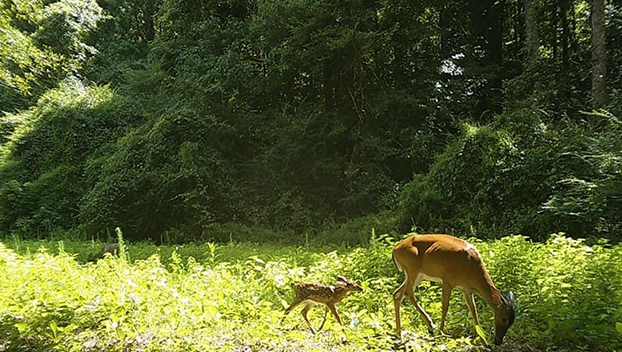Peak fawn drop begins
Published 1:30 pm Monday, July 29, 2024

- It is almost peak fawning time in Southwest Mississippi. Fawns like this one hide in thick cover early in its life before it is old enough to move with its mother. This doe and fawn are in a food plot next to thick cover. It is best for habitat managers to wait to mow or bush hog fields until August to avoid harming fawns or young turkey poults. (Hunter Cloud’s Trail Cam | The Daily Leader)
BROOKHAVEN — The time window for peak white-tailed deer fawn drop in Lincoln County is now until August 5. Fawns are most vulnerable in the first weeks of life to predation from coyotes and bobcats although some will simply die from disease, emaciation or birth defects.
Habitat is critical at this point in the year to protect fawns from predation. It is best for land owners and habitat managers to wait to mow areas of thick, brushy cover until the fawning period ends. Even then, brush hogging and mowing are not the best management practices for habitat.
Fawns are naturally adapted to hide in cover. Mississippi State deer lab states that when fawns sense a threat they will bed down, lower their head to the ground and lay back their ears. At the same time, deer slow down heart rates to appear “life-less.” A fawn’s breathing will stop temporarily to ensure a predator can not hear a fawn breathing, it also reduces the likelihood of the predator smelling a fawn as the breath contains odors.
Most people remember the spotted coat of Bambi in the Disney classic. The spotted coat acts as a camouflage and mimics the broken pattern of sunlight filtering through vegetation according to the MSU deer lab.
Does will come back
Does take great care in hiding fawns and the fawn will often lay still making people think they are sick or injured. It is important to remember the fawn is not abandoned, it is just well hidden. Leave fawns alone.
After a few weeks, a fawn can follow its mother and outrun most of its predators. Until then, does return to their fawns every 4 to 6 hours to nurse and will typically move them to a new spot.
Hunters, habitat managers and landowners can help fawns hide by encouraging early successional habitat in areas making it difficult for coyotes to find fawns.
One way to check if you have good fawning cover is to throw a basketball out into a space. If you can’t find it and have a hard time reaching for it due to thorns it is an excellent fawning cover.
Early successional habitat is also helpful for encouraging plant growth which provides quality deer nutrition needed by does as they lactate in the summer stress period.




